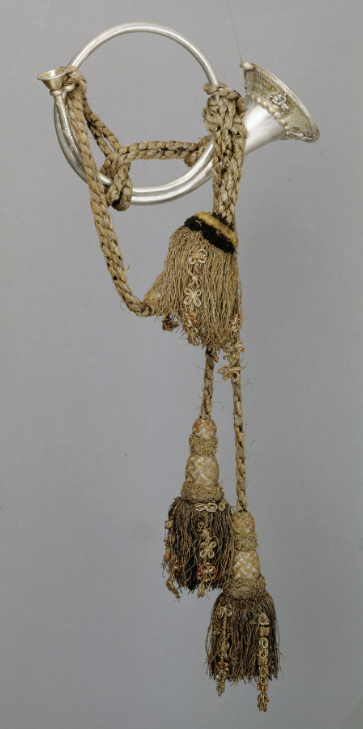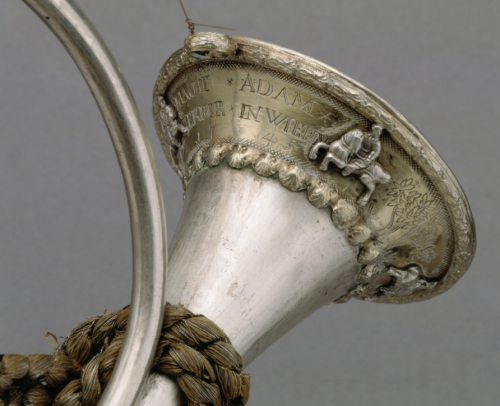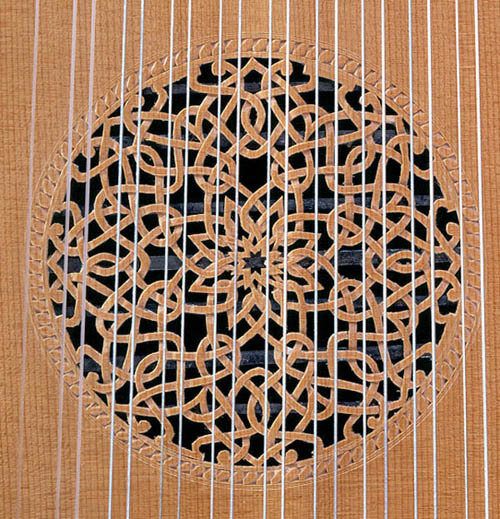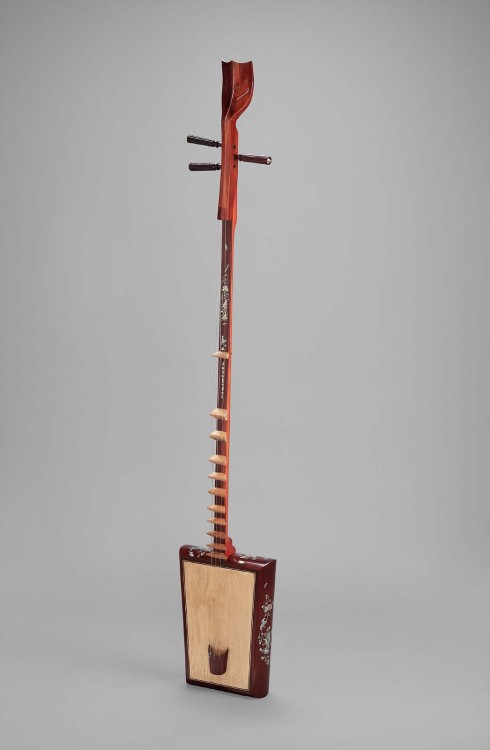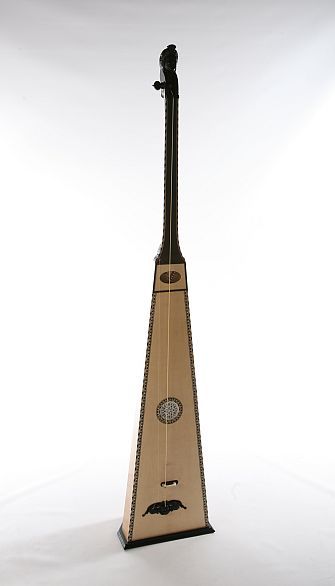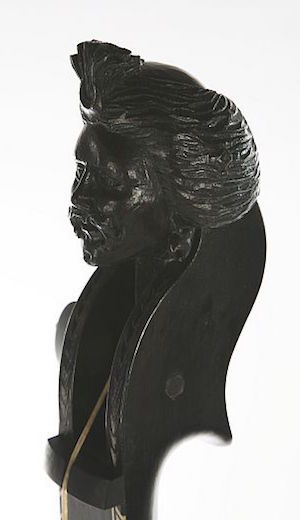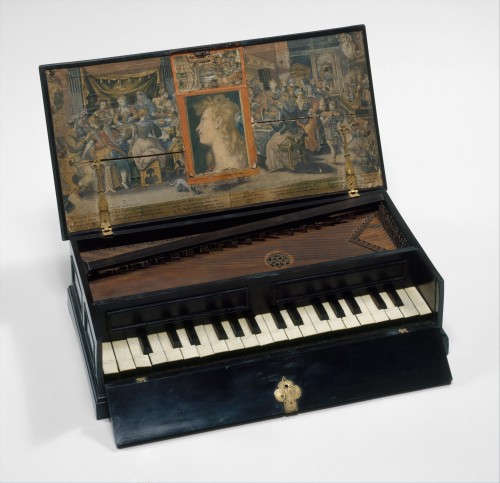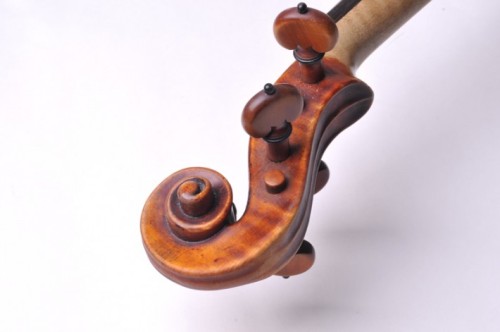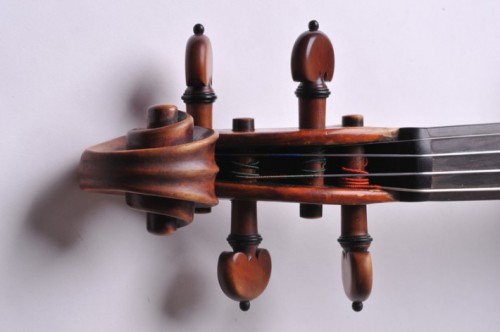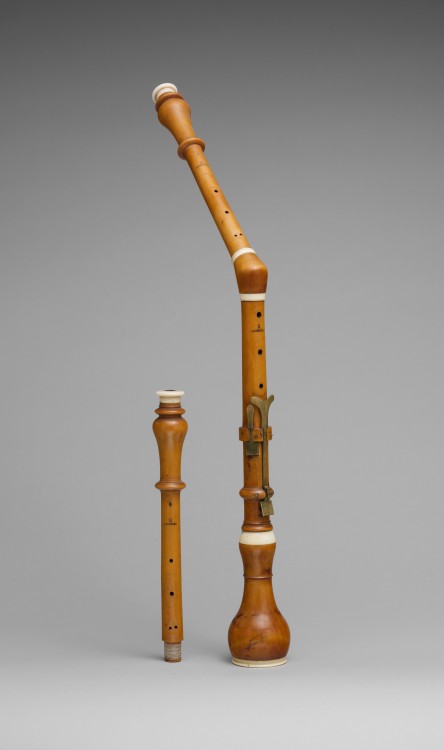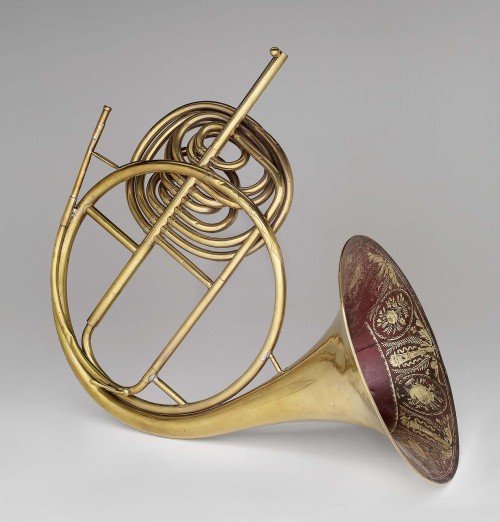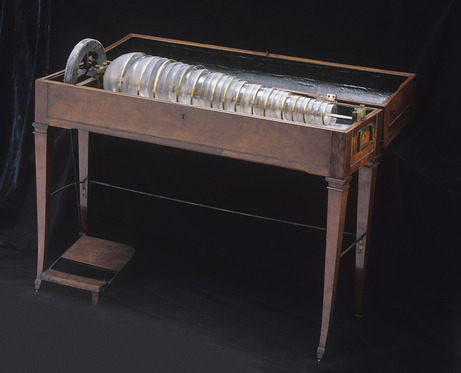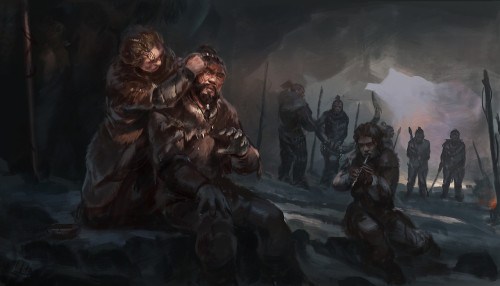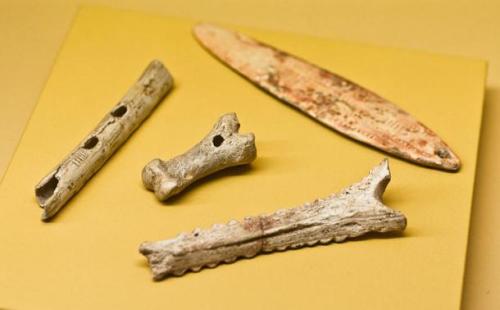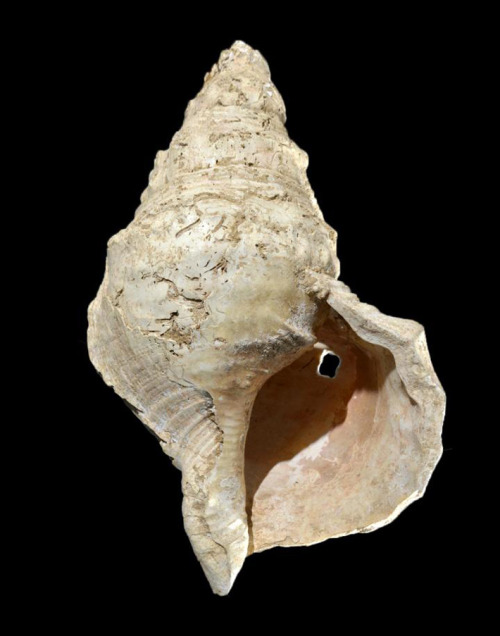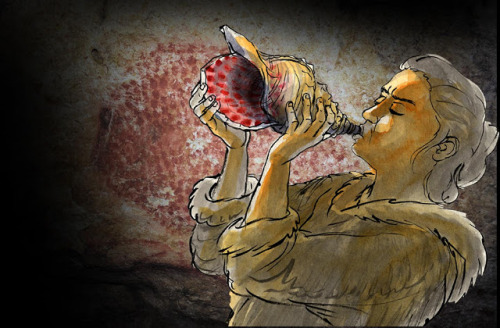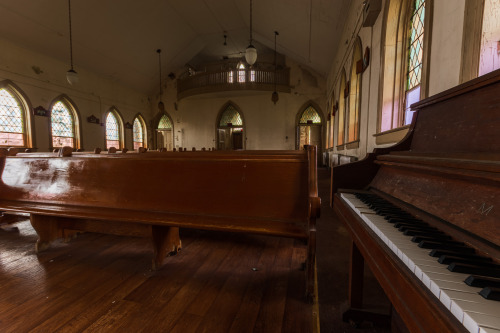#musical instruments
Post Horn, ca. 1745
Adam Ferber (Vienna, Austria)
-Materials: Silver
-Other Notes: The engraving reads “Macht Adam Ferber In Wienn”.
Post link
Lute, ca. 1996
Richard Berg (Ottawa, Canada)
-Materials: Body: Rosewood, Spruce • Neck: Ebonized Plywood • Pegbox Design/Other Parts: Recycled Ivory, Plastic
-Length: 50 cm
-Strings: 24 [gut] - 11 double courses, 2 single courses
-Other Notes: Created in the style of a 1596 lute by Hans Burkholzer, later modified by Thomas Edlinger in 1706. The original ivory instrument is in Vienna’s Kunsthistorisches Museum.
Source:Canadian-MoH
Post link
Đàn đáy, ca. 2004
Ta Quang Dong; Tran Quang Hien (Hanoi, Vietnam)
-Materials: Body: wutongandsindora glabra woods • Inlays: Mother-of-Pearl • Other: Bamboo
-Length: 153 cm
-Strings: 3 [nylon?]
-Other Notes: In the late 1900s, a modernized version of đànđáy was created for use in composing at Hanoi Conservatory. Visually similar, but closer to an electric bass with a closed body, metal strings, and no raised frets.
Source:Boston-MFA
Post link
Basset Horn, ca. 1820
Grenser & Wiesner (Dresden, Germany)
-Materials: Body: Boxwood • Parts: Ivory, brass
-Length: ~118.5 cm
-Other Notes: In E-Flat. The basset horn is part of the clarinet family and closest in range to the alto clarinet. It’s not related to any brass families despite the given name.
Source:Boston-MFA
Post link
Tromba Marina
Owen Morse-Brown (England)
-Materials: Body/Top: Cherry/Spruce • Bands: Ebony, holly • Soundhole: Parchment
-Length: Unlisted [possibly around 2 meters]
-Strings: 23 - 1 playing [gut], 22 sympathetic [metal]
-Other Notes: The Tromba Marina is meant to be played entirely with harmonics along the single gut string on the outside, usually with a number of resonating metal strings within the body. The instrument pictured has 22, tuned to the same note as the external string. The bridge has two feet, but one is left to vibrate freely against the spruce top. The amount of vibration can be adjusted minutely using the secondary, smaller string. The result is a very brassy sound, hence being named ‘Trumpet Marine’. Here is a picture of the maker in playing position:

Further reading for the Tromba Marina
Further reading, regarding Vivaldi’s violono in tromba marina
Source:Owen Morse-Brown
Post link
Bass flute in C, ca. 1811-1816
Wigley & McGregor (London, England)
-Materials: Body: Boxwood • Parts: Ivory, brass
-Length: 87.2 cm
Source:Boston-MFA
Post link
Rectangular Octave Virginal, ca. 1600
Augsberg?, Germany
-Materials: Body: Beechwood • Parts: Ebony, ivory, parchment, leather, paper, brass
-Width: 44.1 cm
-Range: 35 keys
-Other Notes: Though the original maker is not listed, the engravings are credited to Hans Sebald Beham and the elder Crispijn van de Passe. The sound hole has a parchment rosette, and there are two additional drawers in the lid. The octaves are quite high in pitch, suggesting it was more for amusement than serious performance.
Source:NY-MetMA
Post link
”Lipiński” Violin, ca. 1715
Antonio Stradivari (Cremona, Italy, 1644-1737)
-Materials: Back/Ribs/Scroll: Maple • Top: Spruce • Parts: Ebony
-Strings: 4
-Other Notes: The Lipinski is noted as one of Stradivari’s finest violins, crafted during his ‘Golden’ period. This violin has lived through many owners, the earliest recorded being Giuseppe Tartini [imbedded link]. In 1849, it reached the hands of Karol Lipiński [linked], Polish composer and virtuoso. Centuries and several violinists later, it’s currently in the hands of Frank Almond, the concertmaster of the Milwaukee Symphony Orchestra.
Well, mostly.
In 2014, Almond was robbed just after a performance and with a violin appraised at about $5 million, it’s no surprise the attack appeared planned. The violin is okay and was recovered about a month later, and currently resides with Almond. The event even spurred a short film in 2016, The Lipinski [linked].
Photo Source: 2012 © Michael Darnton
Information:Appraisal Price;Event Article;Wikipedia
Post link
Drum, ca. 1st century
Unknown, Nasca (Peru)
-Materials: Ceramic
-Length: 45.1 cm • Diameter: 25.4 cm
-Other Notes: “Ceramic drums with central, bulging sounding chambers were made in southern Peru at the turn of the first millennium. Among the most elaborately finished are those of Nasca style. A favored form was one in which a fat-bodied figure was worked into the shape of the instrument. The figure is depicted atop the wide mouth of the drum, over which a skin would have been stretched. The image is symbolically complex; a snake emerges from under the figure’s chin and a killer whale outlines each eye. The killer whales are in profile and show the ‘two-tone’ color differentiation normally given them in Nasca depictions. A headband is wound around the head and tied to form a hornlike projection on the forehead. In back, the figure’s hair is shown as serpents with long tongues.”
Source:NY-MetMA
Post link
Omnitonic Horn, ca. 1833
Charles-Joseph Sax (Brussels, Belgium, 1790-1865)
-Materials: Brass
-Length: 65 cm
-Other Notes: The inside of this bell is lacquered dark cherry-red with trophies and flowers in gold. These horns would either attach all the necessary crooks to the instrument individually or in a successive, compensating system. Manually engaging a switching system – a “tap” – allows the key changes. This horn’s system range allows it to play from B-flat Basso up to a B-flat Alto key.
Source:Boston-MFA
Post link
Davui(shell trumpet), ca. 1800s
Unknown (Fiji)
-Materials: Body: Conch shell • Handle: Plant fibers
-Length: 35.5 cm
-Other Notes: Embouchure is cut into the end of the shell with a fingerhole cut into the side.
Source:Boston-MFA
Post link
Armonica, ca. 1780
F. A. Böhm (Karlsruhe, Germany)
-Materials: Wood, glass, copper alloy, iron, rubber, paper
-Width: 115.8 cm
-Range: 33 glasses (f-sharp to d’“)
-Other Notes: The glasses form a row of bells played by friction [instead of being struck]. The bottom of the case is lined to hold water that wets the glass bowls as they rotate on the axle operated by the treadle, then are stroked with the fingertips. The gold-edged rims sound the accidentals, while the plain sound the natural notes. This automated version of musical glasses, if you will, is originally attributed to Benjamin Franklin in 1761. Haydn, Mozart, Beethoven, and many contemporaries composed for it.
Source:Horniman Museum & Gardens
Post link
The most beautiful thing I have heard all day and you have the opportunity to hear it too.
One of my faves that was lost to the internet is back
does anyone know the name of this instrument and possibly the source of this video?
it’s a hang drum :)
Everytime I see this I reblog.
Handpans ftw!

Glitz and Glam.

Stage Boy.

Red Rocker.

Showtime hues.


Santo
Possible Prehistoric Musical Instruments
Music is a great passion of mine so I have wondered for a long time if our earliest prehistoric ancesters in Europe were capable of creating music and how? I’ve done some research on this subject, have also visited several prehistoric instruments stored at an archeological depot and I own several replicas based on archeological finds. Here is a list of possible prehistoric instruments.
Unfortunately we will never know what melodies or rhythms our ancestors played on their musical instruments. We can only try to reproduce these instruments and experience/listen to the sounds that they could have produced. We do know that creating music wasn’t solely an activity practiced by us, Homo Sapiens. In the Divje babe cave, a flute was found made from the left thighbone of a young cave bear and it has been dated to around 60,000 years old. This was before modern humans settled themselves in Europe so this flute must have been created and played by the Neanderthals.
Wind instruments:
-Transverse flutes
-Vertical flutes
-Oblique flutes
-Trumpet-like instruments made from shells or gourds
-Didgeridoo
-Panflute
-Whistles
-Ocarinas
Instruments made with skins
-Handdrum
-Pottery drum
-Frame drum
-Cylinder drum
-Friction drum
Instruments you can shake/rub or struck
-Rattles
-Rasps
-Bells
-Bullroarer
-Click sticks
-Xylophone
-Ung-Klung
Instruments with strings
-Mouth harp
-Resonator bow
-Lute/lyre
-Earth bow
I see a lot of people, especially those interested in old Nordic music such as Danheim/Wardruna etc.. loving the Tagelharpa. The act of using a bow to drag it over strings in order to produce a sound, such as the tagelharpa, is actually quite a recent invention. The bow was invented around the 16th century. Tagelharpas described in the eddas were actually not played with a bow but as a lyre.
I hope this post has given some of you more of an insight in the types of instruments our paleolithic ancestors could have played. Perhaps this serves as inspiration to recreate these instruments and try them out, it’s a lot of fun.
Here are images of:
Neanderthal bone flute 60,000 years old,
A bullroarer,
Possible cone shell instrument found in the Marsoulas cave, France,
A paleolithic woman playing the sea shell instrument art by Gilles Tosello,
Neanderthals preparing for the hunt, one plays the flute, artist currently unknown for now,
Post link
TheBBC Merlin SountrackhadNO RIGHT to go that hard.
Listen to this! 2:10 - 2:41 of ‘Merlin buries lancelot’ has me in literal CHILLS. The grief and loss and magic and love that crescendo conveys is just so extraordinary I have to go and be alone for a while.
Me, ignorant, having only ever heard take me to church; Geez what is up the the hozier fandom???
Me, later, after listening to work song; *instanly transported to old woodland in a time long ago* oh.
This is the Balboa Park Spreckels Organ Pavillion, a giant outdoor concert organ which you see here ; https://www.youtube.com/watch?v=vV0xtS2k3lM
From the photo album of my great uncle Lawrence Krettler’s travels in the US Navy aboard the USS Altair 1923 - 1933 total mileage 85,020
Post link

I was sent some instruments, so I made an unboxing video and played some Zelda

